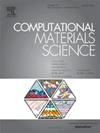Grain growth in thin films – When the third dimension matters
IF 3.3
3区 材料科学
Q2 MATERIALS SCIENCE, MULTIDISCIPLINARY
引用次数: 0
Abstract
The tendency for lowering Gibbs free energy drives the complex three-dimensional process of grain boundary motion. The evolution of the grain structure is governed by the interplay between the preservation of the local balance in the grain boundary network with respect to, for example, dihedral angles along triple lines, and the overall volume conservation. Grain growth has traditionally been studied primarily in two dimensions. Experimental analyses of two-dimensional sections have been conducted, and corresponding numerical simulations in two dimensions have been performed. Such two-dimensional simulations have persisted for thin films up until recently. We demonstrate that the three-dimensional grain boundary motion in thin films cannot be modeled by two-dimensional considerations. In order to achieve that goal, we discuss the evolution of a three-dimensional grain structure in a highly textured thin film with one particularly large grain added. The migration of its boundary depends strongly on both, the location of the particular grain and the morphology of the matrix grains. Such a dependence can indeed only be captured in three dimensions.

薄膜中的晶粒生长-当第三维度起作用时
降低吉布斯自由能的趋势驱动了复杂的晶界三维运动过程。晶粒结构的演变是由晶界网络中局部平衡的保存(例如沿三线的二面角)和整体体积守恒之间的相互作用所控制的。传统上,对晶粒生长的研究主要是二维的。对二维截面进行了实验分析,并进行了相应的二维数值模拟。直到最近,这种二维模拟一直存在于薄膜中。我们证明了薄膜中的三维晶界运动不能用二维考虑来建模。为了实现这一目标,我们讨论了在高度织构的薄膜中添加一个特别大的晶粒的三维晶粒结构的演变。其边界的迁移很大程度上取决于两个因素,即特定晶粒的位置和基体晶粒的形态。这种依赖关系确实只能在三维空间中得到体现。
本文章由计算机程序翻译,如有差异,请以英文原文为准。
求助全文
约1分钟内获得全文
求助全文
来源期刊

Computational Materials Science
工程技术-材料科学:综合
CiteScore
6.50
自引率
6.10%
发文量
665
审稿时长
26 days
期刊介绍:
The goal of Computational Materials Science is to report on results that provide new or unique insights into, or significantly expand our understanding of, the properties of materials or phenomena associated with their design, synthesis, processing, characterization, and utilization. To be relevant to the journal, the results should be applied or applicable to specific material systems that are discussed within the submission.
 求助内容:
求助内容: 应助结果提醒方式:
应助结果提醒方式:


